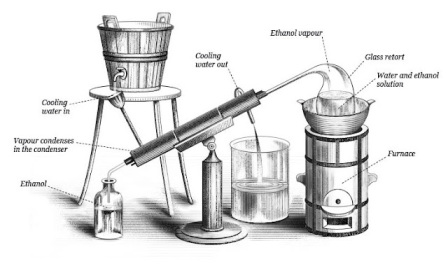FACTS ABOUT ALCOHOL
The concentration of alcohol in a beverage is usually stated as the percentage of alcohol by volume ABV, the number of milliliters (ml) of pure ethanol in 100 ml of beverage.
The ranges of alcohol contained in a beverage are different; it can be from 5% (Beer) up to 70-90% (Absenta) between this two drinks there is a huge variety of alcoholic grading.
Alcohols are carbon-based compounds in which one or more hydrogen atoms in an alkane have been replaced by an -OH group. They can be “primary alcohols” (if the carbon which carries the -OH group is only attached to one alkyl group.), “secondary alcohols” (if the carbon with the -OH group attached is joined directly to two alkyl groups) or “tertiary alcohols” (if the carbon atom holding the -OH group is attached directly to three alkyl groups). The length of the chain affect their boiling point, as larger chains require more energy to break their bonds.
Related to our organism
Unlike food, alcohol travels easily through our body and about 20% of the alcohol that we consume is absorbed immediately into our blood. The most known and common effect of alcohol is happiness and the feeling of inhibition, however inside, our bodies suffer a little bit.
Some effects are:
Liver: On average, it takes the liver about one hour to break down one unit of alcohol. Its effects include: Steatosis, or fatty liver, Alcoholic hepatitis, Fibrosis and Cirrhosis.
Pancreas: Alcohol causes the pancreas to produce toxic substances that can eventually lead to pancreatitis, a dangerous inflammation and swelling of the blood vessels in the pancreas that prevents proper digestion.
Some effects are:
Liver: On average, it takes the liver about one hour to break down one unit of alcohol. Its effects include: Steatosis, or fatty liver, Alcoholic hepatitis, Fibrosis and Cirrhosis.
Pancreas: Alcohol causes the pancreas to produce toxic substances that can eventually lead to pancreatitis, a dangerous inflammation and swelling of the blood vessels in the pancreas that prevents proper digestion.
Brain: It interferes with the brain’s conections, and can affect the way the brain looks and works. These disruptions can change mood and behaviour, and make it harder to think clearly, our vision and coordination are also affected.
Heart: Some diseases produced by alcohol in our hearts include Cardiomyopathy, Arrhythmias, Stroke, High blood pressure.
Immune System: Drinking too much can weaken your immune system, making your body a much easier target for disease.

Heart: Some diseases produced by alcohol in our hearts include Cardiomyopathy, Arrhythmias, Stroke, High blood pressure.
Immune System: Drinking too much can weaken your immune system, making your body a much easier target for disease.

Fermented Beverages
Fermented beverages are produced through the process of fermentation. Fermentation in the case of alcoholic beverages refers to a metabolic process by which yeast converts sugar to ethanol. Yeast is a type of fungus used in the fermentation of alcohol. In order for fermentation to take place, you begin with some type of carbohydrate that is needed to feed the yeast. The type of carbohydrate used determines what the final product will be.
For example, beer is produced by fermenting grain, wine or hard cider is produced by fermenting fruit.

Distilled Beverages
Whisky is made by distilling a specific type of beverage which is beer.
In order to produce beverages above the concentration of ethanol achieved through fermentation, a distillation process is used. Distillation of alcoholic beverages is the process by which water is removed from a mixture of ethanol and water.
During distillation, the difference in the boiling points of water and alcohol is used to separate the two liquids from each other. Ethanol has a lower boiling point, so when heated, it will evaporate more easily. The evaporated steam is then cooled back into a liquid with a higher concentration of ethanol. The distilled beverage is then usually aged for a period of time before drinking. This adds to the flavor of the beverage.
A typical concentration of ethanol in a distilled alcoholic beverage is around 40%, but this can vary greatly.

Alcoholic Tests
These tests are used by police to indirectly measure how much alcohol is in a person’s blood. (Alcohol breath tests are usually given at traffic stops—much easier and safer than trying to do blood tests at the side of the road!)
- When a person drinks alcohol, it goes into the stomach and small intestine and is quickly absorbed in the blood.
- Within minutes of a person having an alcoholic drink, that person’s BAC can be measured. BAC usually reaches its highest level about an hour after drinking.
- About 90 percent of any alcohol consumed is broken down by the liver; the rest is eliminated through urine and breath.
- The breath-testing device converts the amount of alcohol in the breath to a corresponding BAC.
Wines in Argentina
Wines are the main beverage prepared in Argentina, by the quality of grapes (consequence of the clime) the variety of wines created in the country is very wide and it can be exported by it's high quality. The wine is a distilled drink, for the red wine the process is made with the grape itself, with the solid parts and filtered later.
Although it is in spanish here we have a presentation about wines in Argentina
Although it is in spanish here we have a presentation about wines in Argentina
No hay comentarios:
Publicar un comentario